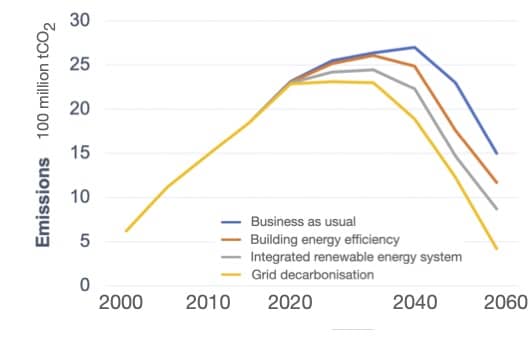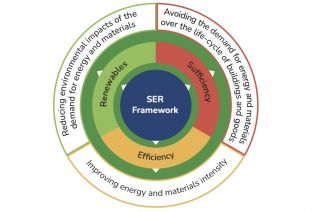
www.buildingsandcities.org/insights/commentaries/cop26-china.html
What China's Carbon Neutrality Means for its Building Stock

By Wei Yang and Jie Li (Tianjin University, CN)
China's pledge to become carbon neutral will have profound effects on its existing and new buildings. Scalable scenarios from national to district levels have been created to begin a process of assessing and apportioning carbon budgets. A range of new economic, social and technical measures will be needed to achieve this radical transformation.
In June 2015, China provided its Nationally Determined Contribution to the Paris Agreement: its overall carbon emissions would peak around 2030 (Department of Climate Change, National Development and Reform Committee of China, 2015). At the end of 2020, President Xi Jinping (2020) stated China's new national goal of carbon neutrality: to become carbon neutral before 2060 with a peak in carbon emissions before 2030 and more than 65% reduction per GDP carbon intensity (based on the 2005 level). Roadmaps for fulfilling those overarching goals have been planned at national, regional, and urban levels, and even for each urban district.
Buildings and the built environment contribute about half of the China's total carbon emissions. Building operation accounts for about 22% of the national energy-related emissions, whereas the embodied emissions in the construction materials, construction operations along with associated transport contributes a further 28% of the national total.
The main strategies for reaching carbon neutrality in the building stock include increasing the energy efficiency of the new and existing buildings, extensive application of building integrated renewable energy, decarbonization of the energy sources (mainly the grid electricity), electrification of the building energy system, and the carbon sink of natural vegetation and water bodies (Figure 1). Moreover, carbon capture & storage will facilitate the last step to reach the carbon neutrality goal (China Association of Building Energy Efficiency, 2020).
Scenario studies had shown that strict measures should be taken immediately in order to keep the temperature rise within 1.5 oC and to reach carbon neutrality by 2060. The construction rate of new buildings (about 4 billion m2 per year) has remained steady in the recent years (National Bureau of Statistics of China, 2020). It is expected that the building stock will grow at the same rate in the next decade in the business-as-usual scenario. In order to reach the carbon neutrality targets, all new and existing buildings will need to be zero carbon in the operational stage, which means a vast amount of investment. The roadmap studies for peak carbon and carbon neutrality at smaller scale had shown dilemmas for future new construction and the carbon reduction goals. Although the national targets do not simply scale down evenly to each individual district, there is still a need to restrict the amount of new construction and at the same time improving the sustainability of the existing building stock - approximately 66 billion m2 (China Association of Building Energy Efficiency, 2020). This suggests there will be a great need for energy efficient retrofit in the coming decades (Chen et al., 2020). Therefore, higher education and professional education will gradually emphasise the sustainable management of the existing building stocks and energy efficient / zero-carbon retrofit. Specific programs on those topics are expected to be established in the near future.
Scenario and policy studies had shown that stricter building energy saving targets and standards are needed and a life cycle approach should be applied. China has already issued the Building Carbon Emission Calculation Standard (MOHURD, 2019a) and the Technical Standard for Nearly Zero Energy Building (MOHURD, 2019b). Subsidies are available for ultra-low energy buildings and building integrated renewable energy utilization. The costs of solar PVs had decreased by 80% in the last 10 years. R&D for sustainable building materials also contributes to the reduction of embodied carbon. Carbon trading will be introduced into the building and real estate sector, and this will improve the economic feasibility of zero-carbon buildings and the energy efficient retrofit of existing buildings. Nonetheless, it is more important to consider the carbon emissions of the whole building stock in a long-term and life cycle perspective, and to plan the roadmaps at different scales and different sectors with a holistic understanding of the built environment.
References
Chen, B., Faeste, L., Jacobsen, R., Kong, M.T., Lu, D. & Palme, T. (2020). How China Can Achieve Carbon Neutrality by 2060. https://www.bcg.com/publications/2020/how-china-can-achieve-carbon-neutrality-by-2060
China Association of Building Energy Efficiency. (2020). China Building Energy Research Report [in Chinese] https://www.cabee.org/site/content/24021.html
Department of Climate Change, National Development and Reform Committee of China. (2015). Enhanced Actions on Climate Change: China's Intended Nationally Determined Contributions. https://www4.unfccc.int/sites/submissions/INDC/Published%20Documents/China/1/China%27s%20INDC%20-%20on%2030%20June%202015.pdf
MOHURD (2019a). Building Carbon Emission Calculation Standard (GB/T51366-2019).http://download.mohurd.gov.cn/bzgg/gjbz/GBT%2051366-2019%20%E5%BB%BA%E7%AD%91%E7%A2%B3%E6%8E%92%E6%94%BE%E8%AE%A1%E7%AE%97%E6%A0%87%E5%87%86.pdf
MOHURD (2019b) Technical Standard for Nearly Zero Energy Building (GB/T51350-2019). http://download.mohurd.gov.cn/bzgg/gjbz/GBT%2051350-2019%20%E8%BF%91%E9%9B%B6%E8%83%BD%E8%80%97%E5%BB%BA%E7%AD%91%E6%8A%80%E6%9C%AF%E6%A0%87%E5%87%86.pdf
National Bureau of Statistics of China. (2020). China Statistical Yearbook 2020, Beijing: China Statistics Press. Table 14-23.
Xi, Jiang (2020). Speech at Climate Ambition Summit. https://www.chinadaily.com.cn/a/202012/13/WS5fd575a2a31024ad0ba9b7ac.html
Latest Peer-Reviewed Journal Content
A living lab approach to co-designing climate adaptation strategies
M K Barati & S Bankaru-Swamy
Mediation roles and ecologies within resilience-focused urban living labs
N Antaki, D Petrescu, M Schalk, E Brandao, D Calciu & V Marin
Negotiating expertise in Nepal’s post-earthquake disaster reconstruction
K Rankin, M Suji, B Pandey, J Baniya, D V Hirslund, B Limbu, N Rawal & S Shneiderman
Designing for pro-environmental behaviour change: the aspiration–reality gap
J Simpson & J Uttley
Lifetimes of demolished buildings in US and European cities
J Berglund-Brown, I Dobie, J Hewitt, C De Wolf & J Ochsendorf
Expanding the framework of urban living labs using grassroots methods
T Ahmed, I Delsante & L Migliavacca
Youth engagement in urban living labs: tools, methods and pedagogies
N Charalambous, C Panayi, C Mady, T Augustinčić & D Berc
Co-creating urban transformation: a stakeholder analysis for Germany’s heat transition
P Heger, C Bieber, M Hendawy & A Shooshtari
Placemaking living lab: creating resilient social and spatial infrastructures
M Dodd, N Madabhushi & R Lees
Church pipe organs: historical tuning records as indoor environmental evidence
B Bingley, A Knight & Y Xing
A framework for 1.5°C-aligned GHG budgets in architecture
G Betti, I Spaar, D Bachmann, A Jerosch-Herold, E Kühner, R Yang, K Avhad & S Sinning
Net zero retrofit of the building stock [editorial]
D Godoy-Shimizu & P Steadman
Co-learning in living labs: nurturing civic agency and resilience
A Belfield
The importance of multi-roles and code-switching in living labs
H Noller & A Tarik
Researchers’ shifting roles in living labs for knowledge co-production
C-C Dobre & G Faldi
Increasing civic resilience in urban living labs: city authorities’ roles
E Alatalo, M Laine & M Kyrönviita
Co-curation as civic practice in community engagement
Z Li, M Sunikka-Blank, R Purohit & F Samuel
Preserving buildings: emission reductions from circular economy strategies in Austria
N Alaux, V Kulmer, J Vogel & A Passer
Urban living labs: relationality between institutions and local circularity
P Palo, M Adelfio, J Lundin & E Brandão
Living labs: epistemic modelling, temporariness and land value
J Clossick, T Khonsari & U Steven
Co-creating interventions to prevent mosquito-borne disease transmission in hospitals
O Sloan Wood, E Lupenza, D M Agnello, J B Knudsen, M Msellem, K L Schiøler & F Saleh
Circularity at the neighbourhood scale: co-creative living lab lessons
J Honsa, A Versele, T Van de Kerckhove & C Piccardo
Positive energy districts and energy communities: how living labs create value
E Malakhatka, O Shafqat, A Sandoff & L Thuvander
Built environment governance and professionalism: the end of laissez-faire (again)
S Foxell
Co-creating justice in housing energy transitions through energy living labs
D Ricci, C Leiwakabessy, S van Wieringen, P de Koning & T Konstantinou
HVAC characterisation of existing Canadian buildings for decarbonisation retrofit identification
J Adebisi & J J McArthur
Simulation and the building performance gap [editorial]
M Donn
Developing criteria for effective building-sector commitments in nationally determined contributions
P Graham, K McFarlane & M Taheri
Join Our Community

The most important part of any journal is our people – readers, authors, reviewers, editorial board members and editors. You are cordially invited to join our community by joining our mailing list. We send out occasional emails about the journal – calls for papers, special issues, events and more.
We will not share your email with third parties. Read more



Latest Commentaries
COP30 Report
Matti Kuittinen (Aalto University) reflects on his experience of attending the 2025 UN Conference of the Parties in Belém, Brazil. The roadmaps and commitments failed to deliver the objectives of the 2025 Paris Agreement. However, 2 countries - Japan and Senegal - announced they are creating roadmaps to decarbonise their buildings. An international group of government ministers put housing on the agenda - specifying the need for reduced carbon and energy use along with affordability, quality and climate resilience.
Building-Related Research: New Context, New Challenges
Raymond J. Cole (University of British Columbia) reflects on the key challenges raised in the 34 commissioned essays for Buildings & Cities 5th anniversary. Not only are key research issues identified, but the consequences of changing contexts for conducting research and tailoring its influence on society are highlighted as key areas of action.